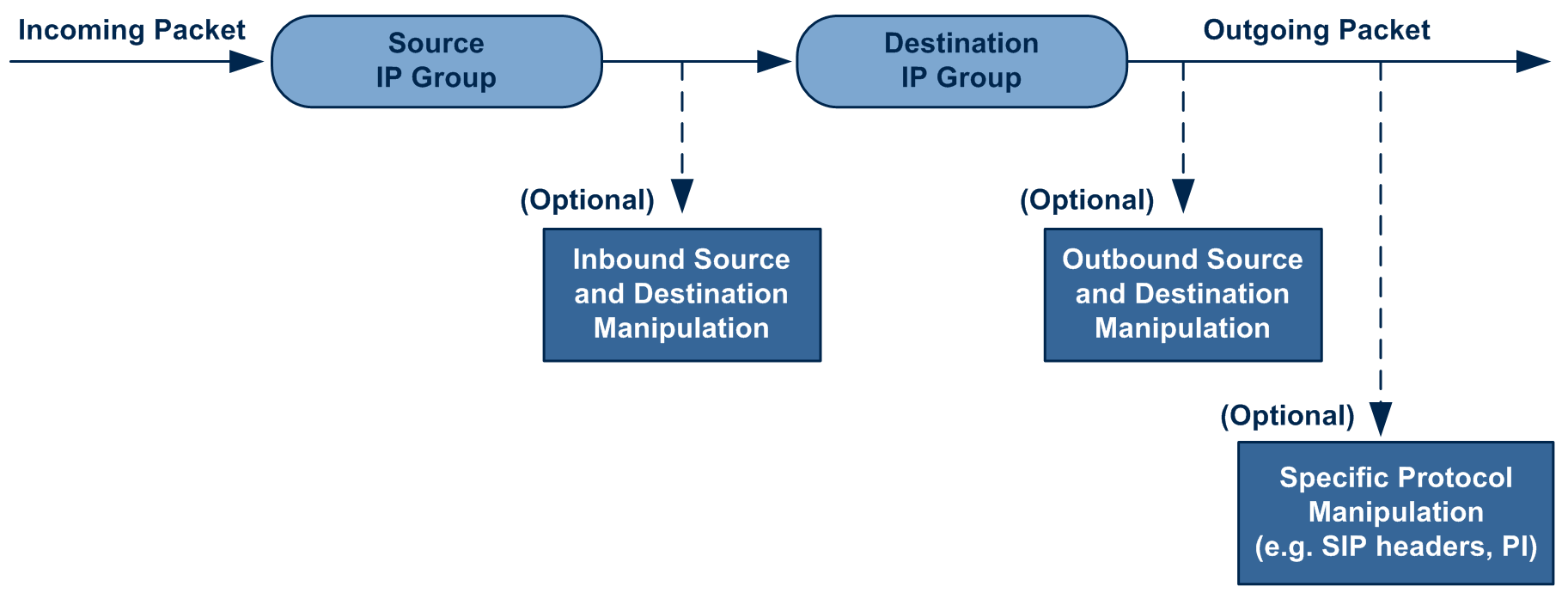SBC Manipulations
This section describes the configuration of the manipulation rules for the SBC application.
For additional manipulation features, see the following:
| ● | Configuring SIP Message Policy Rules |
| ● | Configuring SIP Message Manipulation |
The device supports SIP URI user part (source and destination) manipulations for inbound and outbound routing. These manipulations can be applied to a source IP group, source and destination host and user prefixes, and/or user-defined SIP request (e.g., INVITE, OPTIONS, SUBSCRIBE, and/or REGISTER). Since outbound manipulations are performed after routing, the outbound manipulation rule matching can also be done by destination IP Group. Manipulated destination user and host are performed on the following SIP headers: Request-URI, To, and Remote-Party-ID (if exists). Manipulated source user and host are performed on the following SIP headers: From, P-Asserted (if exists), P-Preferred (if exists), and Remote-Party-ID (if exists).

You can also restrict source user identity in outgoing SIP dialogs in the Outbound Manipulation table (using the column PrivacyRestrictionMode). The device identifies an incoming user as restricted if one of the following exists:
| ■ | From header user is 'anonymous'. |
| ■ | P-Asserted-Identity and Privacy headers contain the value 'id'. |
All restriction logic is done after the user number has been manipulated.
Host name (source and destination) manipulations are simply host name substitutions with the names defined for the source and destination IP Groups respectively (if any, in the IP Groups table).
Below is an example of a call flow and consequent SIP URI manipulations:
| ■ | Incoming INVITE from LAN: |
INVITE sip:1000@10.2.2.3;user=phone;x=y;z=a SIP/2.0
Via: SIP/2.0/UDP 10.2.2.6;branch=z9hGLLLLLan
From:<sip:7000@10.2.2.6;user=phone;x=y;z=a>;tag=OlLAN;paramer1=abe
To: <sip:1000@10.2.2.3;user=phone>
Call-ID: USELLLAN@10.2.2.3
CSeq: 1 INVITE
Contact: <sip:7000@10.2.2.3>
Supported: em,100rel,timer,replaces
Allow: REGISTER,OPTIONS,INVITE,ACK,CANCEL,BYE,NOTIFY,PRACK
User-Agent: Sip Message Generator V1.0.0.5
Content-Type: application/sdp
Content-Length: 155
v=0
o=SMG 791285 795617 IN IP4 10.2.2.6
s=Phone-Call
c=IN IP4 10.2.2.6
t=0 0
m=audio 6000 RTP/AVP 8
a=rtpmap:8 pcma/8000
a=sendrecv
a=ptime:20
| ■ | Outgoing INVITE to WAN: |
INVITE sip: 9721000@ITSP;user=phone;x=y;z=a SIP/2.0
Via: SIP/2.0/UDP 212.179.1.12;branch=z9hGWwan
From: <sip:97000@IP_PBX;user=phone;x=y;z=a>;tag=OWan;paramer1=abe
To: <sip: 9721000@ ITSP;user=phone>
Call-ID: USEVWWAN@212.179.1.12
CSeq: 38 INVITE
Contact: <sip:7000@212.179.1.12>
Supported: em,100rel,timer,replaces
Allow: REGISTER,OPTIONS,INVITE,ACK,CANCEL,BYE,NOTIFY,PRACK,REFER
User-Agent: Sip Message Generator V1.0.0.5
Content-Type: application/sdp
Content-Length: 155
v=0
o=SMG 5 9 IN IP4 212.179.1.11
s=Phone-Call
c=IN IP4 212.179.1.11
t=0 0
m=audio 8000 RTP/AVP 8
a=rtpmap:8 pcma/8000
a=sendrecv
a=ptime:20
The SIP message manipulations in the example above (contributing to typical topology hiding) are as follows:
| ■ | Inbound source SIP URI user name from "7000" to "97000": |
From:<sip:7000@10.2.2.6;user=phone;x=y;z=a>;tag=OlLAN;paramer1=abe
to
From: <sip:97000@IP_PBX;user=phone;x=y;z=a>;tag=OWan;paramer1=abe
| ■ | Source IP Group name (i.e., SIP URI host name) from "10.2.2.6" to "IP_PBX": |
From:<sip:7000@10.2.2.6;user=phone;x=y;z=a>;tag=OlLAN;paramer1=abe
to
From: <sip:97000@IP_PBX;user=phone;x=y;z=a>;tag=OWan;paramer1=abe
| ■ | Inbound destination SIP URI user name from "1000" to 9721000": |
INVITE sip:1000@10.2.2.3;user=phone;x=y;z=a SIP/2.0
To: <sip:1000@10.2.2.3;user=phone>
to
INVITE sip:9721000@ITSP;user=phone;x=y;z=a SIP/2.0
To: <sip:9721000@ITSP;user=phone>
| ■ | Destination IP Group name (SIP URI host name) from "10.2.2.3" to "ITSP": |
INVITE sip:1000@10.2.2.3;user=phone;x=y;z=a SIP/2.0
To: <sip:1000@10.2.2.3;user=phone>
to
INVITE sip:9721000@ITSP;user=phone;x=y;z=a SIP/2.0
To: <sip:9721000@ITSP;user=phone>